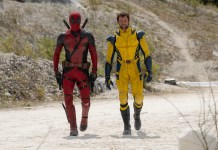 The Wolverine finally brings to the big screen the story of James Howlett Wolverine Logan’s time in Japan. And while Hollywood has made countless movies set in the country over the last seven decades, the island nation still managed to pose a new set of challenges and opportunities for director of The Wolverine, James Mangold, and his cast and crew.
The Wolverine finally brings to the big screen the story of James Howlett Wolverine Logan’s time in Japan. And while Hollywood has made countless movies set in the country over the last seven decades, the island nation still managed to pose a new set of challenges and opportunities for director of The Wolverine, James Mangold, and his cast and crew.
CASTING
“We wanted a real Japanese cast, yet we needed bilingual Japanese actors, and a lot of them”, explains Mangold. This may seem like a simple requirement, but given how few high-profile Japanese actors also work within Hollywood, it was one that took some work to fulfil. “It’s a pretty miraculous cast,” Mangold continues, ” Hiro Sanada was someone I was after from the beginning… He’s a phenomenal actor. On top of that, he’s one of the biggest action stars in Japan”.
In the movie, Sanada plays Shingen Yashida, the father of Logan’s love interest, Mariko, and a man with a rather dubious moral compass. Mariko is played by model-turned-actress Tao Okamoto, while the core Japanese cast is rounded out by another not-so-former model, Rila Fukushima, in the role of Yukio: a childhood friend of Mariko, who becomes Logan’s partner in crime. “There’s a vast array of women in this movie”, Mangold points out, “It was really important to have a variety of women in the picture, and strong women, each representing a different point of view.”


“It’s always bugged me”, Mangold confesses, “ in more modern films when you have Japanese characters who are alone with each other in Japan, speaking English”. Because of this, the director was determined that scenes in his movie where Japanese characters interact would be carried out in their native tongue. Unfortunately, with hundreds of millions of dollars on the line, it’s not quite as simple as that.
“I was terrified that if I sent dailies back to 20th Century Fox in Japanese, they’d freak out”, the solution was simple, “I shot in Japanese and English hoping all the time that I’d cut the movie in Japanese and they wouldn’t have a problem with it later.”
Which solved a problem for Mangold and his production team, but made things a little more difficult for the cast, “We had to memorise both languages, especially when we were having a sequence with just Japanese cast”, Tao Okamoto recalls, “The director was like, ‘OK, this time, Japanese. Go’, and then right away, he was like, ‘English now. Go’ and then he’d say, ‘from the beginning to here, English, and the rest Japanese. Go’”.
Her cast mate, Rila Fukishima elaborates, “It was torture sometimes. English and Japanese are two different languages, with different grammar. Japanese has more syllables than English, so even if you say, ‘I love you’, it’s three syllables, but in Japanese, it’s going to be five. It’s going to get longer. So we don’t want to lose the motivation, but we have to put a lot of work in for one sentence.”


Ultimately, Mangold was pleased with the way this worked out, “in a way it helped me, because I could stage it with the actors, and stage the scenes, and understand and actually direct them in English, and then they could play it in English, and we could convert the scene back in its native language.”
THE WEST’S FASCINATION WITH JAPAN


For Lee, this fascination bled into his filming experience, “I think the coolest part of shooting in a place like Japan is that you know you’re in Japan. There are so many places that I’ve shot around the world where you look to your left or look to your right and there’s a Starbucks or a McDonalds; you kind of could be anywhere, whereas when you’re in Japan, you know you’re in Japan.”
“There was a sequence where I’m running and following Wolverine along the rooftops in Japan, in the city atmosphere, and it’s just amazing to see from that point of view, how big Japan felt.”
The movie may be set in Japan, but in the same way the previous X-Men films don’t accurately depict the US, The Wolverine takes a few liberties with its host country, as Fukushima reveals, “It’s a little bit different. It’s actually, in some parts, a lot different, but I think it’s a real mix of Western culture and Eastern culture.”
“it’s X-Men world, it’s like comic world. So my character was taking care of the comic part, I guess; my character wasn’t really authentic Japanese… There are no red-haired girls running around the park, using Japanese swords… My character is in between, connected to the X-Men world, and Japan.”
The Wolverine is in cinemas from today, you can read our review here.









